TurntablePSU.comReviews and Technical Analysis
Phoenix Engineering Falcon
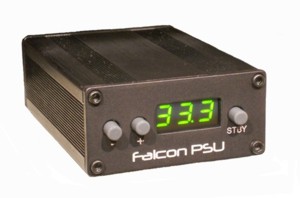
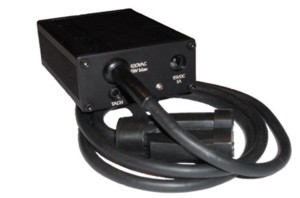
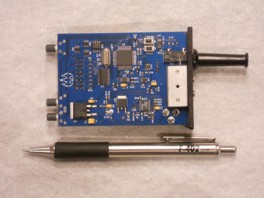
Overview
The $379 Falcon is a Variable Frequency Drive (VFD) that uses Direct Digital Synthesis (DDS) to generate the sinewave signal. The unit uses an Atmel AT89C52 microprocessor to control the DDS circuit, the display and accept commands from the user. The clock source for the microprocessor is an 8.388608MHz crystal oscillator with a frequency stability of .01% (100 PPM) and also serves as the reference source for the DDS. The display uses 3 seven segment LEDs to indicate speed and the front panel has 3 buttons to switch between 33/45 RPM and to control the output frequency for each speed in 0.1 RPM steps. The front panel buttons also access a number of set up and programming modes.
The Falcon will enter sleep mode (blank display) while in standby mode if there is no activity for 5 minutes.
The Falcon is powered by a universal input (100-260VAC 50/60Hz) wall adapter that provides 15V at 1.5A max and the PSU has one output for 115VAC motors, rated at 5W maximum. The output voltage will revert to user programmed voltage between 115VAC and 85VAC in 1 volt steps after approximately 3 seconds. The 3 digit display shows the operating speed in RPM and in normal operation, the +/- buttons change the speed in 0.1 RPM steps. The standby button changes between 33/45 RPM (short press) or puts the unit into standby mode (long press). The Falcon will work with 50Hz/60Hz motors and can be programmed for small or large spindle. The output is 115VAC only.
The PSU can be used at 78 RPM if the motor is fitted with the optional pulley and an internal jumper is installed. The PSU still operates at 33 and 45 RPM, but a 3rd selection is added to the speed menu for 78 RPM and the belt is moved to the largest of the 3 spindles.
The other operating modes are entered by using the front panel keys:
Holding (+) key while exiting Standby: Frequency calibration mode in 0.01 RPM steps.
Holding (-) key while exiting Standby: Reduced voltage programming (separate settings for 33/45/78 RPM).
Holding (+) key while inserting power: Pulley selection mode (50/60Hz & large/small spindle).
Holding (+) & (-) key will inserting power: Resets unit to factory defaults.
The Falcon PSU can also be used with the company's RoadRunner tachometer. When connected to the tach via a 3 wire serial cable, the speed adjustment is automatic and corrects for long term speed drift as well as errors do to belt/pulley/platter tolerances, belt tension, bearing changes etc.
The Falcon is housed in a one piece aluminum extrusion with black anodized finsih. The front and rear panels are 0.125" black anodized aluminum.
Circuit Description
The Falcon PSU uses an Analog Devices 28 bit DDS to generate the sinewave. The microprocessor divides the crystal frequency down to produce the MCLK signal for the DDS and controls the frequency generation in 35µHz steps. There is no output transformer so the unit is very small and light. Instead the Falcon has a built in high voltage DC supply and uses a directly coupled high voltage amplifier for the output. Because of its small size, the case does get slightly warm when run at full power for any length of time.
Measurements
The output frequency at 33.3 RPM measured 60.00 Hz and 81.00 Hz at 45 RPM. Adjustment range of the speed was from ±1 RPM in 0.1 RPM steps (normal mode) for both 33 and 45 RPM modes and ±6RPM in 0.1 RPM steps for 78 RPM mode. No load voltage was 114.1/101.2VAC (full/reduced); the output dropped to 112.9/101.2VAC at 5W. The temperature topped out at 112°F after 45 minutes.
Specifications
Nominal Speeds...........................33 and 45 RPM (78 RPM Optional internal jumper).
Speed Stability.............................0.01%
Distortion (Freq Generator).............0.014%
Distortion (115VAC output).............0.28%
Pitch Control................................±1.0 RPM in 0.1 RPM steps (normal mode) 0.01 RPM steps (calibration mode)
Output Power...............................5W
Output Impedance........................<1 Ohm
Reduced Voltage..........................115VAC-75VAC in 4V steps
Turntable Connection....................NEMA 5-15 socket on 30" cable 115VAC
Input...........................................15VDC 1.5A
Dimensions.................................2.5"W x 3.565"L x 1.1875"H
Weight........................................8 Oz.
Retail..........................................$379
Phoenix Engineering Eagle
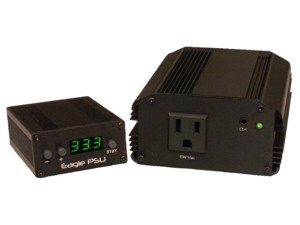
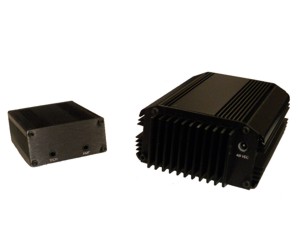
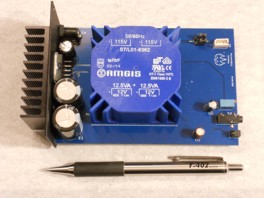
Overview
The $525 Eagle is a Variable Frequency Drive (VFD) that uses Direct Digital Synthesis (DDS) to generate the sinewave signal. The Eagle is a 2 pc supply with the controller nearly identical to the Falcon PSU and a separate high power amplifier unit that can be located remotely. The two are connected via a 6ft 3.5mm stereo cable. The unit uses an Atmel AT89C52 microprocessor to control the DDS circuit, the display and accept commands from the user. The clock source for the microprocessor is an 8.388608MHz crystal oscillator with a frequency stability of .01% (100 PPM) and also serves as the reference source for the DDS. The display uses 3 seven segment LEDs to indicate speed and the front panel has 3 buttons to switch between 33/45 RPM and to control the output frequency for each speed in 0.1 RPM steps. The front panel buttons also access a number of set up and programming modes.
The controller will enter sleep mode (blank display) while in standby mode if there is no activity for 5 minutes. There is a single bi-color LED on the amplifier to indicate standby/sleep mode (red) or amplifier output on (green).
The Eagle is powered by a universal input (100-260VAC 50/60Hz) wall adapter that provides 24V at 2.5A max and the PSU has one output for 115/230VAC motors, rated at 25W maximum. The output voltage will revert to user programmed voltage between 115/230VAC and 75/150VAC in 4/8 volt steps after approximately 3 seconds. The 3 digit display shows the operating speed in RPM and in normal operation, the +/- buttons change the speed in 0.1 RPM steps. The standby button changes between 33/45 RPM (short press) or puts the unit into standby mode (long press). The Eagle is front panel programmable for 50Hz/60Hz motors. The output is jumper selectable internally for 115/230VAC.
The PSU can be used at 78 RPM if the motor is fitted with the optional pulley and an internal jumper is installed. The PSU still operates at 33 and 45 RPM, but a 3rd selection is added to the speed menu for 78 RPM and the belt is moved to the largest of the 3 spindles.
The other operating modes are entered by using the front panel keys:
Holding (+) key while exiting Standby: Frequency calibration mode in 0.01 RPM steps.
Holding (-) key while exiting Standby: Reduced voltage programming (separate settings for 33/45/78 RPM).
Holding (+) key while inserting power: Pulley selection mode (50/60Hz & large/small spindle).
Holding (+) & (-) key will inserting power: Resets unit to factory defaults.
The Eagle PSU can also be used with the company's RoadRunner tachometer. When the controller is connected to the tach via a 3 wire serial cable, the speed adjustment is automatic and corrects for long term speed drift as well as errors do to belt/pulley/platter tolerances, belt tension, bearing changes etc.
The Eagle control unit is housed in a one piece aluminum extrusion with black anodized finsih. The front and rear panels are 0.125" black anodized aluminum. The Eagle amplifier is housed in a black anodized aluminum extrusion with heat sink fins. The amplifier front and rear panels are 0.062" black anodized aluminum.
Circuit Description
The Eagle controller uses the same Analog Devices DDS and control scheme to generate the sinewave as the Falcon. The controller appears to be the same circuit as the Falcon with all of the high voltage and high power circuits removed. The controller gets its power and delivers its 4VPP output over a 3 wire 6ft cable that connects it to the amplifier unit. The amplifier uses an ST7492 single chip amp with the output directly coupled to the 25W toroid 12 volt secondary. The dual windings of the high voltage side of the transformer provide the output and are either in parallel (115VAC out) or in series (230VAC out) via two small jumpers located on the amplifier PCB.
Measurements
The output frequency at 33.3 RPM measured 60.00 Hz and 81.00 Hz at 45 RPM. Adjustment range of the speed was from ±1 RPM in 0.1 RPM steps (normal mode) for both 33 and 45 RPM modes and ±6RPM in 0.1 RPM steps for 78 RPM mode. No load voltage was 117.1/102.3 VAC (full/reduced); the output dropped to 115.0/100.5 VAC at 5W, 112.2/98.2 VAC at 10W and 109.1/96.0VAC at 20W. The amplifier temperature topped out at 90°F (20W) after 45 minutes.
Specifications
Nominal Speeds...........................33 and 45 RPM (78 RPM Optional internal jumper).
Speed Stability.............................0.01%
Distortion (Freq Generator).............0.014%
Distortion (115VAC output).............0.35%
Pitch Control................................±1.0 RPM in 0.1 RPM steps (normal mode) 0.01 RPM steps (calibration mode)
Output Power...............................25W
Output Impedance........................65 Ohms
Reduced Voltage..........................115/230VAC to 75/170VAC in 4/8 volt steps
Turntable Connection....................NEMA 5-15 socket on amplifier front panel 115VAC/230 VAC
Input...........................................24VDC 2.5A
Dimensions (controller).................2.5"W x 3.565"L x 1.1875"H
Dimensions (amplifier)..................4"W x 6"L x 2"H
Weight........................................5 lbs.
Retail..........................................$525
Phoenix Engineering RoadRunner Tachometer
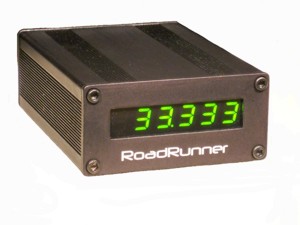
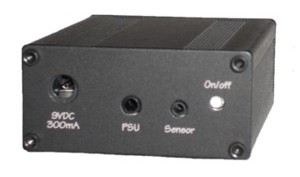
Overview
The $235 RoadRunner is a high resolution digital tachometer that measures the actual platter speed and displays the result on a 6 digit LED display in real time. The tach uses a small magnet attached to the platter and a sensor PCB attached to the plinth to measure the platter speed and can be used while playing music. A connection on the back provides a serial output that when connected to the Falcon or Eagle PSU, will automatically correct the platter speed to within ±0.005 RPM of what is displayed on the PSU front panel.
There is an on/off button on the rear panel; pressing and holding this button will put the tachometer into sleep mode (blank display) and a short press will wake up the unit. The RoadRunner will also revert to sleep mode if the platter stops rotating for more than 5 minutes and will automatically exit sleep mode when the platter starts rotating.
The RoadRunner is powered by a universal input (100-260VAC 50/60Hz) wall adapter that provides 9V at 300mA. The RoadRunner is housed in the same one piece aluminum extrusion as the Falcon or Eagle controller. The front and rear panels are 0.125" black anodized aluminum.
Circuit Description
The RoadRunner uses an Atmel AT8952 microprocessor for measuring the speed and controlling the display. The clock source is a 2.5PPM (0.00025%) TCXO at 18 MHz. The sensor PCB contains a small Hall Effect sensor and protection diodes and is connected to the display unit via a 3ft 2.5mm to 3.5mm RA cable.
Specifications
Display.....................................6 digit LED Direct frequency readout of platter speed in RPM.
Resolution.................................0.001 RPM
Serial Data................................3.5mm connector 9600N81 DCE
Frequency Stability....................2.5 PPM (±0.00025%)
Input.........................................9VDC 300mA
Dimensions ..............................2.5"W x 3.565"L x 1.1875"H
Weight......................................4 oz.
Retail........................................$235